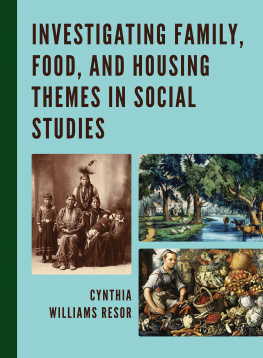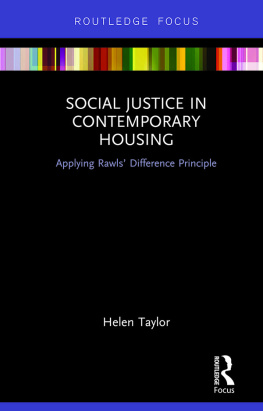Investigating Family, Food, and Housing Themes in Social Studies
Investigating Family, Food, and Housing Themes in Social Studies
Cynthia Williams Resor
Rowman & Littlefield
Lanham Boulder New York London
Published by Rowman & Littlefield
A wholly owned subsidiary of The Rowman & Littlefield Publishing Group, Inc.
4501 Forbes Boulevard, Suite 200, Lanham, Maryland 20706
www.rowman.com
Unit A, Whitacre Mews, 26-34 Stannary Street, London SE11 4AB
Copyright 2017 by Cynthia Williams Resor
All rights reserved. No part of this book may be reproduced in any form or by any electronic ormechanical means, including information storage and retrieval systems, without writtenpermission from the publisher, except by a reviewer who may quote passages in a review.
British Library Cataloguing in Publication Information Available
Library of Congress Cataloging-in-Publication Data
Names: Resor, Cynthia Williams, 1966- author.
Title: Investigating family, food, and housing themes in social studies / Cynthia Williams Resor.
Description: Lanham, Maryland : Rowman & Littlefield, 2017. | Includes bibliographical references and index.
Identifiers: LCCN 2017029597 (print) | LCCN 2017041118 (ebook) | ISBN 9781475832037 (electronic) | ISBN 9781475832006 (hardcover : alk. paper) | ISBN 9781475832020 (pbk. : alk. paper)
Subjects: LCSH: Social sciencesStudy and teaching (Secondary) | Social sciencesStudy and teaching (Middle School) | Social sciencesResearchMethodology. | Families. | Food--Social aspects. | Housing.
Classification: LCC H62 (ebook) | LCC H62 .R4625 2017 (print) | DDC 300.71/2dc23
LC record available at https://lccn.loc.gov/2017029597
 The paper used in this publication meets the minimum requirements of American National Standard for Information SciencesPermanence of Paper for Printed Library Materials, ANSI/NISO Z39.48-1992.
The paper used in this publication meets the minimum requirements of American National Standard for Information SciencesPermanence of Paper for Printed Library Materials, ANSI/NISO Z39.48-1992.
Printed in the United States of America
Cover image credits: Frank A Rinehart, Photographer. Sauk Indian Family, Omaha, Nebraska, ca. 1899.(Courtesy of Library of Congress); Currier & Ives. Home Sweet Home , hand-colored lithograph, c. 18561907. (Courtesy of Library of Congress); Joachim Beuckelaer. Market Woman with Fruit, Vegetables and Poultry , painting, 1564. (Courtesy Wikimedia Commons)
To my grandmothers,
Helen Williams (19121998) and Mae Vanhooser (19012009)

Contents

Authors Note
Visit the companion website teachingwiththemes.com for the following:
- More primary sources, texts, and images related to the themes of family, food, and housing.
- Information about additional publications by this author.
- A feedback form. Please share your experiences and suggestions using the themes, primary sources, and recommendations in this book.

Introduction
Is that really a thing? This commonly heard question conveys our confusion about whether a new trend is really that popular. Modern media barrages us with new things that promise to transform our daily lives: new looks, new diets, new gadgets, new apps, new behaviors, or new slang. Should we jump on the bandwagon to join others who appear convinced this new thing is making their lives better?
Asking Is that a thing? communicates more than our desire to be up-to-date; it also reveals an underlying skepticism. Maybe the popularity of this new thing is really an illusion created by its promoters. Someone wants to convince us to join the crowd, but what is in it for them? How do we critically assess what appear to be popular trends in a world filled with conflicting advice? How do we decide if something is really a thing?
These questions are at the core of this book. Messages about how one ought to behave, what one ought to be, do, or buy have existed in every era and every culture. People throughout time have consciously and subconsciously measured themselves against the recommended things of their era. Today, and in the past, people question, analyze, conform, transform, or reject the conventions of their culture.
The following chapters revolve around social history themes related to daily lifefamily, food, and housing. Family, food, and shelter are realities required by everyone for survival, then and now. But family, food, and home are also subjective concepts with meanings that vary. These words can mean different things, to different people, at different times and places. Often, subjective meanings communicate not what is real , but what ought to be an ideal . Historians must distinguish between real and ideal, objective and subjective. They must ask, Was that really a thing?
On one hand, historians study very real, objective, concrete objects and topics, seeking to reconstruct who was included in historical families, what did their dwellings look like, what foods were eaten. On the other hand, historians study idealized and abstract concepts of family, food, and housing. They ask how descriptions and depictions of home expressed the cultural norms of the dominant group of people. How did table manners and silverware convey social status? How did preparing food transmit messages about what is feminine or masculine?
Historical documents and images, or primary sources, convey objective facts, but they also convey subjective concepts of the author and culture. Documents and images are often prescriptive , communicating how people ought to act, not necessarily how different groups of people really did act. Most sources represent the reality for some groups, but fail to acknowledge the very different lives of others.
Our students must sort out, or critically assess, messages from the modern media, just as historians analyze primary sources. This book is about examining the past and asking, Is that really a thing? and encouraging students to ask the same question about modern culture. What should be believed, what rejected? Who is giving the advice? Why do they want me to adopt that viewpoint? How does it confirm or conflict with my experience and backgroundmy family, my friends, my social class, my ethnicity, my culture, my sex, my gender? How does it confirm or conflict with the person I want to be?
Sometimes we ask, When did that become a thing? This question reflects how we cope with change in daily life. We live in an era of social, economic, technological, and political change. Its hard to keep up with the newest thing while carrying on with lifeschool, work, family, friends, and daily routines. It is easy to miss the big shifts in society.
Change over time and the transformation in daily life from the pre-industrial to the modern era is examined in each of the following chapters. Historical time is a long game, hard to imagine when viewed from the perspective of just one human life. For the first five thousand years of recorded pre-industrial history, change was slow and almost imperceptible in daily lives of average people. Nearly every aspect of those millennia was completely different from the daily routines of modern students.
Then, in just three hundred years, from the eighteenth into the twentieth century, the Industrial Revolution altered how humans lived their daily lives. The change came at different rates in difference places. Some people experienced radical change in their lifetime; others continued to live pre-industrial lives into the twentieth century. Some idealized past conventions; others embraced a new way of life.
Next page










 The paper used in this publication meets the minimum requirements of American National Standard for Information SciencesPermanence of Paper for Printed Library Materials, ANSI/NISO Z39.48-1992.
The paper used in this publication meets the minimum requirements of American National Standard for Information SciencesPermanence of Paper for Printed Library Materials, ANSI/NISO Z39.48-1992.